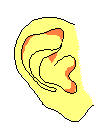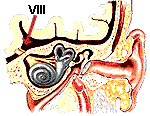 |
|
|||
 | The Ear |  | ||
| The ears contain structures for both the sense of hearing and the sense of balance. The eighth cranial nerve (vestibulocochlear nerve made up of the auditory and vestibular nerves) carries nerve impulses for both hearing and balance from the ear to the brain. |  |

Hearing (Audition) Sound waves cause the tympanic
membrane (eardrum) to vibrate. Humans can hear sounds waves with
frequencies between 20 and 20,000 Hz. The three bones in the ear (malleus,
incus, stapes) pass these vibrations on to the cochlea. The cochlea is a
snail-shaped, fluid-filled structure in the inner ear. Inside the cochlea
is another structure called the organ of Corti. Hair cells are located on
the basilar membrane of the cochlea. The cilia (the hair) of the hair
cells make contact with another membrane called the tectorial membrane.
When the hair cells are excited by vibration, a nerve impulse is generated
in the auditory nerve. These impulses are then sent to the brain. Sound waves cause the tympanic
membrane (eardrum) to vibrate. Humans can hear sounds waves with
frequencies between 20 and 20,000 Hz. The three bones in the ear (malleus,
incus, stapes) pass these vibrations on to the cochlea. The cochlea is a
snail-shaped, fluid-filled structure in the inner ear. Inside the cochlea
is another structure called the organ of Corti. Hair cells are located on
the basilar membrane of the cochlea. The cilia (the hair) of the hair
cells make contact with another membrane called the tectorial membrane.
When the hair cells are excited by vibration, a nerve impulse is generated
in the auditory nerve. These impulses are then sent to the brain.(By the way...the stapes is the smallest bone in the human body. It is only 0.25 to 0.33 cm long [0.10 to 0.13 inches] and weighs only 1.9 to 4.3 milligrams.) |
| Loudness is measured in decibels (dB) - this is the
force of sound waves against the ear. The louder the sound, the more
decibels. Here are approximate decibel levels for some everyday
sounds:
|
Did you know? |
At a temperature of 68oF (20oC), sound travels at 1,125 feet/sec (343 meters/sec). This is the same as traveling at 756 miles/hr (1,217 km/hr). Also, as the temperature rises, the speed of sound gets faster. |
Hearing LossLoud noises, infections, head injuries, brain damage and genetic diseases may cause people to lose some or all of their ability to hear. Hearing loss is also common in older people. There are several types of hearing loss:
|

 Take a short on-line, interactive quiz about the
ear. Take a short on-line, interactive quiz about the
ear.
|
 Hear IT! | Cochlea | Decibel | Incus | Malleus |
| Stapes | Tympanic Membrane | Vestibulocochlear Nerve | ||
| Hearing Ranges | |||
| Animal | Low Frequency Limit | High
Frequency Limit | |
| Elephant | 17 | 10,000 | |
| Human | 20 | 20,000 | |
| Cow | 23 | 35,000 | |
| Horse | 55 | 33,500 | |
| Dog | 60 | 45,000 | |
| Monkey | 110 | 45,000 | |
| Rat | 650 | 60,000 | |
| Mouse | 1,000 | 90,000 | |
| Bat | 3,000 | 120,000 | |
| (Source: Schiffman, H.R., Sensation andPerception. An Integrated Approach, New York: John Wiley and Sons, Inc., 2001) | |||

Balance (Vestibular Sense)Balance depends on visual information, "feedback" from muscles and from an inner ear structure called the semicircular canal. The semicircular canal is a set of 3 fluid-filled canals that are aligned at right angles to each other. Within parts of the semicircular canal are hair cells. When the head is moved, the fluid in the canals moves the hair cells and a nerve impulse is generated in the vestibular nerve.Don't try this. The world record (according to the Guinness Book of Records, 1996) for balancing on one foot is 55 hr. 35 min. |

| Did you know?
|
Of course you know that if you spin around in circles you will get dizzy. But do you know why? When you spin, fluid in the semicircular canals of your ear moves around. This stimulates the hair cells. When you stop spinning, the fluid still moves a bit. Because the fluid is still activating hair cells, your brain stills gets a message that you are moving and you feel dizzy. |
Did you know? | 200,000 people in the United States are deaf; 3 million people in the US have serious hearing problems. Gallaudet University in Washington, D.C. is an undergraduate institution for deaf and hard of hearing undergraduate students. |
| BACK TO: | Exploring the Nervous System | Table of Contents |
![[email]](./gif/menue.gif) Send E-mail |
 Get Newsletter |
 Search Pages |
 Donate to Neuroscience for Kids |



